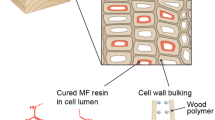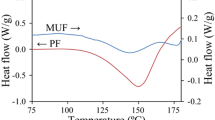Abstract
The curing conditions influence the material properties of wood modified with methylated melamine formaldehyde resin. To identify the most influential parameters, the process conditions were varied separately. The degree of conversion (differential scanning calorimetry; DSC), work in bending, nitrogen fixation, formaldehyde emission, formaldehyde content and content of free formaldehyde were measured to verify the influence of the curing conditions on the material properties. The temperature and duration positively influenced the curing of melamine resin as the DSC results and the nitrogen fixation indicate. However, the relative humidity (RH) had the greatest influence on the material properties: the formaldehyde properties and the work in bending differed most between dry and high RH processes with the latter producing material being less brittle and having lower formaldehyde emissions. It can be derived that DSC measurements, formaldehyde emission and -content are valuable methods to characterize the influence of curing conditions on the material properties. The formaldehyde content in combination with the emission revealed a different formaldehyde release factor for dry and high RH processes. In the future, the curing process conditions can be designed depending on the desired material properties: dry, high temperature processes will lead to more complete curing, whereas hot steam processes can be used for material with low formaldehyde emissions.



Similar content being viewed by others
References
Behr G, Gellerich A, Bollmus S, Militz H (2014) Determining the N-Fixation—a reliable method to verify the curing quality of wood modification with melamine resin? In: European conference on wood modification, Lisbon, Portugal
Behr G, Gellerich A, Bollmus S, Militz H (2015) Different methods of nitrogen analysis and their suitability to control the curing quality of wood modification with melamine resin. In: European conference on wood modification, Helsinki, Finland
Bergmann I, Müller U, Rätzsch M, Steiner M (2006) Investigations on the crosslinking reactions of melamine resins in the presence of wood. Monatshefte Für Chem Chem Mon 137:881–886
Bollmus S (2011) Biologische und technologische Eigenschaften von Buchenholz nach einer Modifizierung mit 1,2-dimethylol-4,5-dihydroxyethylenurea (DMDHEU). [Biological and technological properties of beech wood after modification with 1,2-dimethylol-4,5-dihydroxyethylenurea (DMDHEU)], (In German). Dissertation, Georg-August-Universität Göttingen
DIN 52 186 (1978) Testing of wood; bending test. German Institute for Standardization
DIN EN 120 (1992) Wood-based panels; determination of formaldehyde content; extraction method calles the perforator method. European Committee for Standardization
DIN EN 84 (1997) Wood preservatives—accelerated ageing of treated wood prior to biological testing—Leaching procedure. European Committee for Standardization
EN 717-3 (1996) Wood-based panels—determination of formaledhyde release—Part 3: formaldehyde release by the flask method. European Committee for Standardization
Hill CAS (2006) Wood modification. John Wiley, West Sussex
Holleman AF, Wiberg E, Wiberg N (1995) Lehrbuch der anorganischen Chemie. (Textbook of inorganic chemistry) (In German). de Gruyter, Berlin
Jones FN, Chu GB, Samara Weera U (1994) Recent studies of self-condensation and co-condensation of melamine-formaldehyde resins—cure at low temperatures. Prog Org Coat 24:189–208
Kandelbauer A, Wuzella G, Mahendran A, Taudes I, Widsten P (2009a) Model-free kinetic analysis of melamine–formaldehyde resin cure. Chem Eng J 152:556–565
Kandelbauer A, Wuzella G, Mahendran A, Taudes I, Widsten P (2009b) Using isoconversional kinetic analysis of liquid melamine and formaldehyde resin curing to predict laminate surface properties. J Appl Polym Sci 113:2649–2660
Kielmann BC, Militz H, Mai C, Adamopoulos S (2013) Strength changes in ash, beech and maple wood modified with a N-methylol melamine compound and a metal-complex dye. Wood Res 58:343–350
Kjeldahl J (1883) Neue Methode zur Bestimmung des Stickstoffs in organischen Körpern. (New method for the determination of nitrogen in organic substances) (In German). Z Für Anal Chem 22:366–382
Klüppel A, Mai C (2013) The influence of curing conditions on the chemical distribution in wood modified with thermosetting resins. Wood Sci Technol 47:643–658
Kohlmayr M, Stultschnik J, Teischinger A, Kandelbauer A (2014) Drying and curing behaviour of melamine formaldehyde resin impregnated papers. J Appl Polym Sci 131:3
Krause A (2006) Holzmodifizierung mit N-Methylolvernetzern. (Wood modification with N-methylol crosslinking agents) (In German). Dissertation, Georg-August-Universität Göttingen
Lukowsky D (1999) Holzschutz mit Melaminharzen. (Wood protection with melamine resins) (In German). Dissertation, Universität Hamburg
Lukowsky D (2002) Influence of the formaldehyde content of waterbased melamine formaldehyde resins on physical properties of Scots pine impregnated therewith. Holz Roh Werkst 60(5):349–355
Lukowsky D, Peek R-D, Rapp AO (1998) Curing conditions for a low formaldehyde etherificated melamine resin. In: International research group on wood preservation. IRG Secretary, Stockholm, p 5
Mahnert K-C (2013) Entwicklung eines nichttragenden Boden-belages für den Schiffbau auf Basis ausgewählter Verfahren der Holzmodifizierung (Development of a non-structural decking material for shipbuilding based on selected wood modification processes) (In German). Dissertation, Georg-August-Universität Göttingen
Miroy F, Eymard P, Pizzi A (1995) Wood hardening by methoxymethyl melamine. Holz Roh Werkst 53:276–276
Mizumachi H (1973) Activation energy of the curing reaction of urea resin in the presence of wood. Wood Sci 6:14–18
Mizumachi H, Fujino M (1972) Interaction between wood and polymers. Holzforsch Int J Biol Chem Phys Technol Wood 26:164
Petersen H (1971) Kinetik und Katalyse bei Aminoplastkondensation I—Kinetik und Katalyse der Additionsreaktionen von Aldehyden an NH-gruppenhaltigen Verbindungen (Kinetics and catalysis of aminoplast condensation I—kinetics and catalysis of addition reaction of aldehydes on NH–group containing compounds) (In German). Chem-Ztg 95:625–632
Pizzi A, Panamgama LA (1995) Diffusion hindrance vs wood-induced catalytic activation of MUF adhesive polycondensation. J Appl Polym Sci 58:109–115
Popovic M, Miljkovic J, Budinski Simendic J, Pavlicevic J, Ristic I (2011) Curing characteristics of low emission urea-formaldehyde adhesive in the presence of wood. Wood Res 56:589–600
Rapp A (1999) Physikalische und biologische Vergütung von Vollholz durch Imprägnierung mit wasserverdünnbaren Harzen. (Physical and biological improvement of solid wood through impregnation with water soluble resins) (In German). Dissertation, Universität Hamburg
Schaffert S (2006) Steuerung und Optimierung von Holzvernetzungs-prozessen. (Control and optimization of crosslinking processes for wood) (In German). Dissertation, Georg-August-Universität Göttingen
Scheepers ML, Gelan JM, Carleer RA, Adriaensens PJ, Vanderzande DJ, Kip BJ, Brandts PM (1993) Investigation of melamine-formaldehyde cure by fourier-transform raman-spectroscopy. Vib Spectrosc 6:55–69
Wepner F (2006) Entwicklung eines Modifizierungsverfahrens für Buchenfurniere auf Basis von zyklischen N-Methylol-Verbindungen. (Development of a modification process for beech veneers based on cyclic N-methylol compounds) (In German). Dissertation, Georg-August-Universität Göttingen
Xing C, Deng J, Zhang SY, Riedl B, Cloutier A (2005) Differential scanning calorimetry characterization of urea–formaldehyde resin curing behavior as affected by less desirable wood material and catalyst content. J Appl Polym Sci 98:2027–2032
Author information
Authors and Affiliations
Corresponding author
Rights and permissions
About this article
Cite this article
Behr, G., Gellerich, A., Bollmus, S. et al. The influence of curing conditions on properties of melamine modified wood. Eur. J. Wood Prod. 76, 1263–1272 (2018). https://doi.org/10.1007/s00107-018-1290-3
Received:
Published:
Issue Date:
DOI: https://doi.org/10.1007/s00107-018-1290-3




